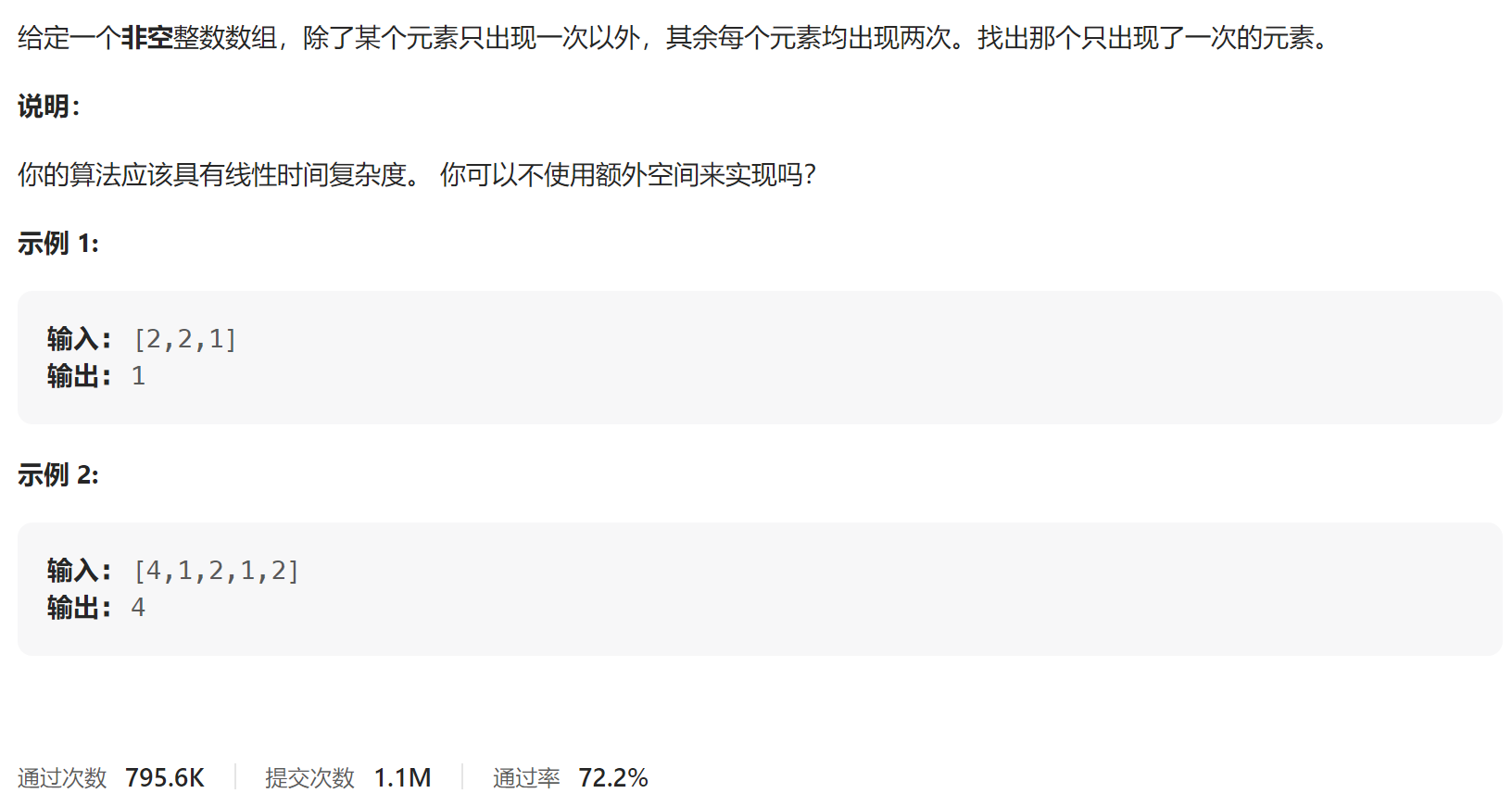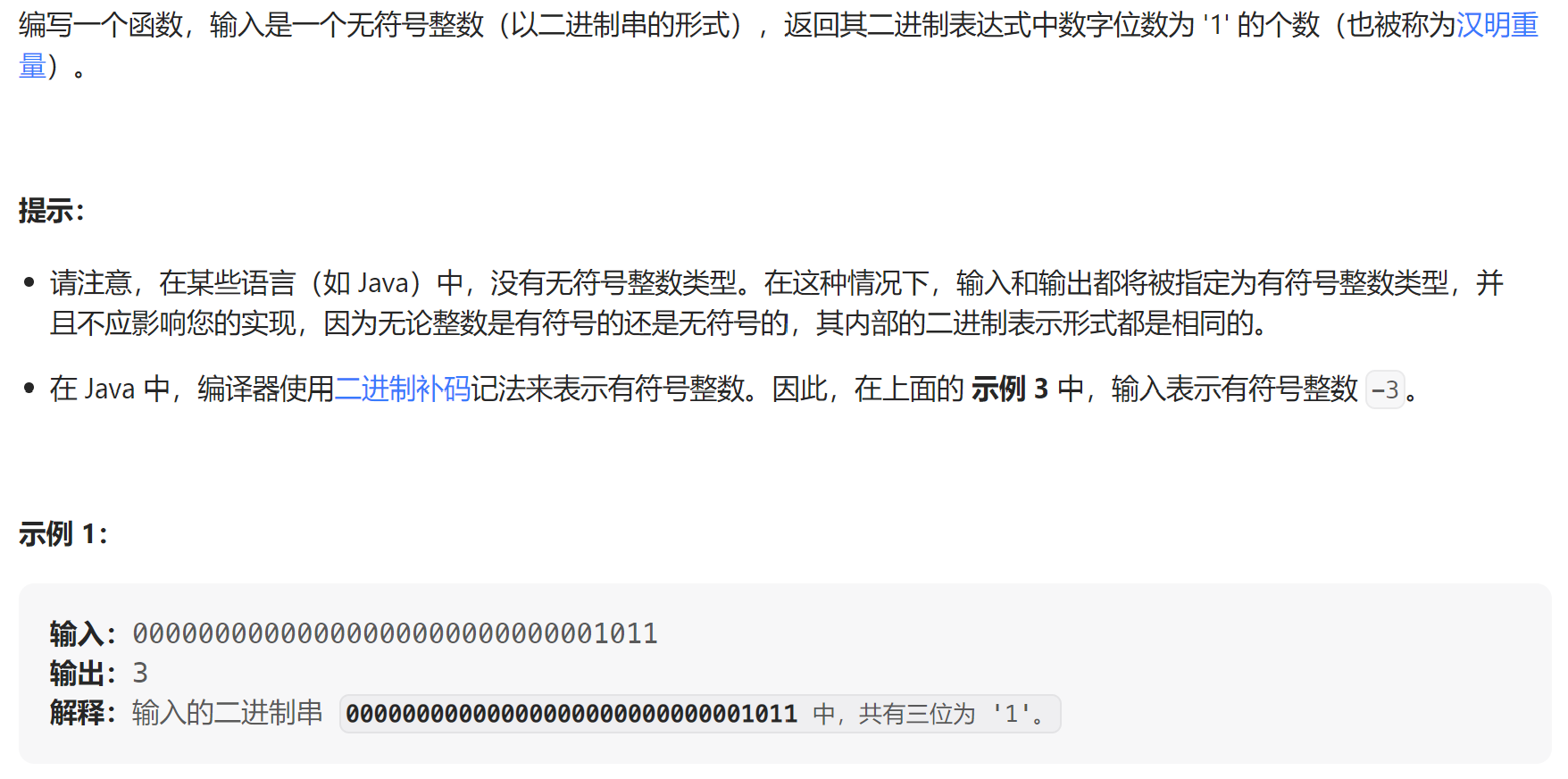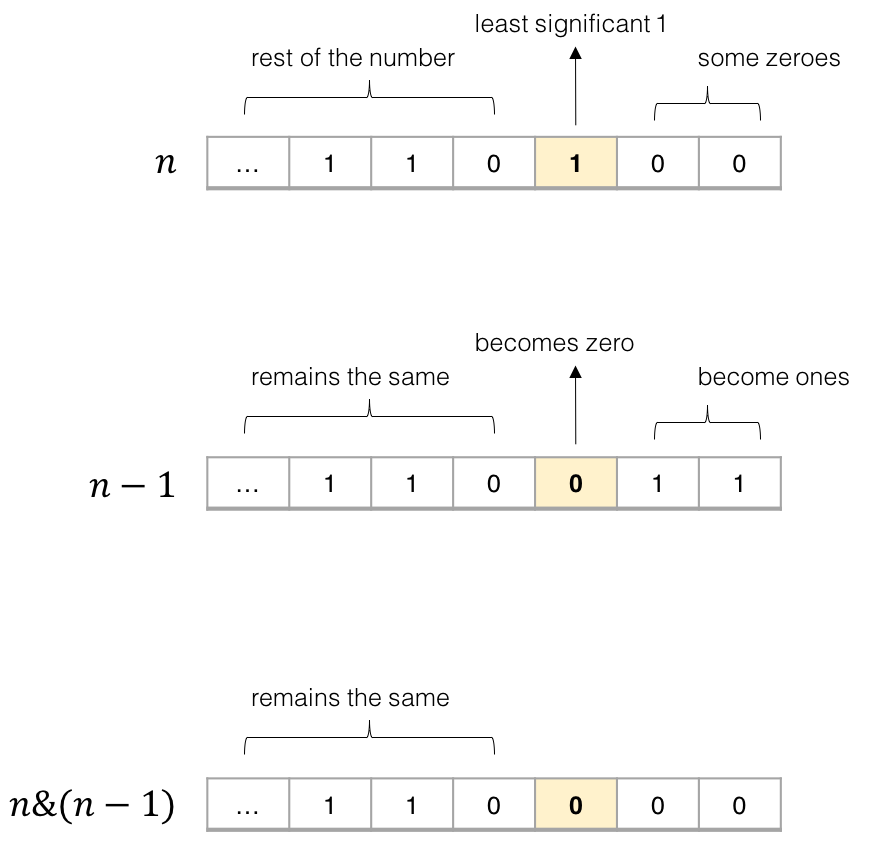LeetCode-位运算
LeetCode 136. 只出现一次的数字
链接:https://leetcode.cn/problems/single-number/

找出数组中唯一成单的数字,主要学习异或运算的性质和哈希表的使用。
解法1. 异或运算
异或运算的三个性质
任何数和0做异或,结果仍是原来的数 $$ a \bigoplus 0 = a $$
任何数和自身做异或结果是0 $$ a \bigoplus a = 0 $$
异或运算满足交换律和结合律 $$ a \bigoplus b \bigoplus a = b \bigoplus a \bigoplus a = b $$
因此数组中所有元素异或即可得到单个的元素。时间复杂度$O(n)$
class Solution {
public int singleNumber(int[] nums) {
int ans = nums[0];
for(int i = 1; i < nums.length; i++){
ans ^= nums[i];
}
return ans;
}
}解法2. 哈希表
使用哈希表存储每个数字和该数字出现的次数。最后次数为1的就是单个数字
Class Solution {
public int singleNumber(int[] nums) {
Map<Integer, Integer> map = new HashMap<>();
for(Integer i : nums){
Integer count = map.get(i);
map.put(i, count == null ? 1 : ++count;);
}
for(Integer i : nums){
if(map.get(i) == 1)
return i;
}
}时间复杂度$O(n)$,空间复杂度$O(n)$
LeetCode 191. 位1的个数 (汉明重量)
链接:https://leetcode.cn/problems/number-of-1-bits/

方法1 - 移位
循环检查二进制的每一位是否为1,例如让n和 $2^i$ 进行与运算,或者让n和1相与并右移n,得到二进制末尾是否为1 时间复杂度$O(k)$, 其中$k$是二进制位数
public class Solution {
// you need to treat n as an unsigned value
public int hammingWeight(int n) {
int count = 0;
while (n != 0) {
count += n & 1;
n >>>= 1;
}
return count;
}
}注,Java中:
<<左移,高位舍弃,低位补0>>右移,舍弃最低位,高位用符号位填补,正数补0,负数补1>>>无符号右移,舍弃最低位,高位用0填补
方法二 - Brian Kernighan 算法
利用 $n \And (n-1)$ 能够把二进制中的最低位1变为0的特性,反复操作,直至n=0

可以看到,n-1会把n末尾的0变1,直到遇到最低位的1把它变0,其余保持不变。相与时,n末尾的0与运算后仍是0,而最低位1和0相与得0,其余位不变。因此,$n \And (n-1)$把n的最低位1变成了0,其余位不变。
时间复杂度$O(logn)$, 循环次数就是n的二进制中1的个数
public class Solution {
public int hammingWeight(int n) {
int ret = 0;
while (n != 0) {
n &= n - 1;
ret++;
}
return ret;
}
}方法3 - 分治 (Variable-Precision SWAR 算法)
0x55555555 = 0B0101...0101 0x33333333 = 0B0011...0011 0x0f0f0f0f = 0B00001111...00001111
贴上Java中的Integer::bitCount()源码,太神奇了!
public static int bitCount(int i) {
i = i - ((i >>> 1) & 0x55555555); // 此时i每两位的值是原数字每两位1的个数
i = (i & 0x33333333) + ((i >>> 2) & 0x33333333); // 此时i每4位的值是原数字每4位1的个数
i = (i + (i >>> 4)) & 0x0f0f0f0f; // 此时i每8位的值是原数字每8位1的个数
i = i + (i >>> 8); // 每两个8位合并统计
i = i + (i >>> 16); // 两个16位合并统计
return i & 0x3f; // 取出低6位,因为32bit最高只有32个1
}注意第二行,前半句保留奇数组的"两位",后半句保留偶数组的"两位",然后相加使得相邻的两个"两位"合并统计,即得到每4位1的个数 分开&的原因在于2bit最多表示3个1,不足以表示原数字每4位1的个数,因此要多做一次&然后相加 而在第三行,4bit(0-15)可以表示8位二进制1的个数,因此只需要&一次
LeetCode 461. 汉明距离
链接:https://leetcode.cn/problems/hamming-distance/

先把两数字异或,然后同LeetCode191,统计1的个数。
class Solution {
public int hammingDistance(int x, int y) {
int s = x ^ y, ret = 0;
while (s != 0) {
s &= s - 1;
ret++;
}
return ret;
}
}